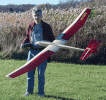Electronics Pioneers & History
- See Full List of AI Topics -
 Lee de Forest was an American inventor and physicist who is widely recognized
as a pioneer in the field of radio and electronic communication. He was born on
August 26, 1873, in Council Bluffs, Iowa, and grew up in Alabama. BTW, the
correct spelling per his own signature (see cover at left) is "de Forest," not
"De Forest," "deForest," or "DeForest." Lee de Forest was an American inventor and physicist who is widely recognized
as a pioneer in the field of radio and electronic communication. He was born on
August 26, 1873, in Council Bluffs, Iowa, and grew up in Alabama. BTW, the
correct spelling per his own signature (see cover at left) is "de Forest," not
"De Forest," "deForest," or "DeForest."
De Forest was educated at the Sheffield Scientific School at Yale University,
where he studied under the famous physicist J.W. Gibbs. He later earned a Ph.D.
in physics from the University of Berlin, where he studied under the renowned physicist
Max Planck.
In 1906, de Forest invented the triode vacuum tube, which allowed electronic signals
to be amplified and helped to revolutionize the field of radio communication. He
later developed other important electronic devices, including the Audion, a vacuum
tube that could detect radio signals, and the oscillating audion, which was used
in early radio transmitters.
The audio tube that Lee de Forest invented is known as the triode vacuum tube,
also called the Audion. The triode was a significant innovation in the field of
electronics because it allowed for the amplification of electronic signals. Prior
to its invention, electronic signals could only be transmitted over short distances
because the signals would quickly weaken and become distorted.
The triode vacuum tube was first introduced by de Forest in 1906, and it was quickly
adopted by radio manufacturers and enthusiasts. The Audion was a three-element vacuum
tube that could amplify radio signals, making it possible to broadcast radio signals
over longer distances than ever before. This made radio broadcasting commercially
viable, and it helped to popularize radio as a means of communication and entertainment.
De Forest continued to work on improving the triode, developing a version that
could be used in early radio transmitters. He also worked on other electronic devices,
including the oscillating audion, which was used to generate radio frequency signals.
The triode vacuum tube had a profound impact on the development of electronics
and communication technology. It laid the groundwork for the development of modern
electronics and helped to pave the way for the development of television, computers,
and other electronic devices. Today, vacuum tubes are no longer commonly used in
electronic devices, having been largely replaced by transistors and integrated circuits,
but they remain an important part of the history of technology.
De Forest was a prolific inventor and held over 180 patents for his work in electronics
and communication. He also worked as a consultant for several major corporations,
including AT&T and RCA.
Lee de Forest was involved in a number of patent lawsuits over the course of his
career. One of the most notable was his dispute with the American Telephone and
Telegraph Company (AT&T) over the patent for the vacuum tube.
In 1915, De Forest filed a patent application for a "wireless telegraphy" system
that used a vacuum tube to amplify signals. However, AT&T claimed that it had
patented a similar device, and a lengthy legal battle ensued.
The lawsuit lasted for over a decade, with both sides presenting numerous technical
arguments and expert witnesses. Ultimately, in 1927, the Supreme Court of the United
States ruled in favor of AT&T, stating that de Forest's vacuum tube was too similar
to AT&T's patented device.
The ruling was a significant blow to De Forest's career, as it limited his ability
to profit from his inventions and prevented him from developing certain technologies.
However, De Forest continued to work as an inventor and consultant, and he made significant
contributions to the development of early television and sound recording technology.
Throughout his career, de Forest was a strong advocate for the development of
radio as a means of communication and entertainment. He gave numerous lectures and
wrote articles and books on the subject, helping to popularize radio and bring it
into the mainstream.
This content was generated by the ChatGPT
artificial intelligence (AI) engine. Some review was performed to help detect and
correct any inaccuracies; however, you are encouraged to verify the information
yourself if it will be used for critical applications. In some cases, multiple solicitations
to ChatGPT were used to assimilate final content. Images and external hyperlinks
have also been added occasionally. Courts have ruled that AI-generated content is
not subject to copyright restrictions, but since I modify them, everything here
is protected by RF Cafe copyright. Your use of this data implies an agreement to
hold totally harmless Kirt Blattenberger, RF Cafe, and any and all of its assigns.
Thank you. Here are the major categories.
Electronics & High Tech
Companies | Electronics &
Tech Publications | Electronics &
Tech Pioneers | Electronics &
Tech Principles |
Tech Standards
Groups & Industry Associations |
Societal Influences on Technology
|



























